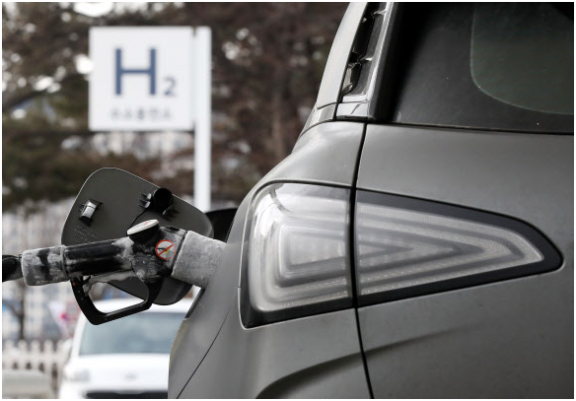KIST and SNU Develop Integrated Fuel Cell with Higher Efficiency

A hydrogen vehicle in the process of charging
The Korea Institute of Science and Technology and Seoul National University announced on March 28 that their joint research team has developed a novel catalyst component capable of enhancing the efficiency of a regenerative fuel cell producing and storing hydrogen by water electrolysis in the event of surplus electricity and generating power with the stored hydrogen when electricity is needed. They explained that the catalyst component is capable of boosting the efficiency of the integrated fuel cell by solving the problem of water-gas mixing in the fuel cell that hinders their movements.
An integrated fuel cell can be defined as an eco-friendly and stand-alone energy storage and power generation device that is more advantageous in terms of price and space than the separate installation of water electrolysis equipment and fuel cells for hydrogen-based power generation.
The integrated fuel cell is capable of producing and storing hydrogen through water electrolysis when the production of electricity from solar power, wind power, or the like exceeds the power demand. In the opposite case, the fuel cell is used for power supply. Once industrialized, it is expected to reduce the instability of renewable energy supply attributable to factors such as weather conditions.
The catalyst part of the fuel cell, where a chemical reaction occurs, requires a smooth water supply along with a quick discharge of generated oxygen and hydrogen gases during the water electrolysis. During the fuel cell operation, the part requires a smooth hydrogen supply and a quick discharge of generated water. The problem with the integrated device is that the water and the gas are mixed to result in water stagnation or the gas fails to escape to cause a decline in efficiency.
The research team reached a conclusion that this problem can be solved by a hydrophilic electrode for a fast water movement and a hydrophobic electrode for a quick gas movement. Then, the team sought a method for applying both to the catalyst.
In order to make a hydrophilic and hydrophobic electrode, the team coated the surface of an electrode with a micro-pattern plastic substance in which hydrophilicity and hydrophobicity alternate. As a result, they succeeded in making an amphipathic catalyst structure.
The team applied the amphipathic catalyst structure to an integrated fuel cell and confirmed that the structure facilitates water and gas movements. “As compared to existing components, the fuel cell operating efficiency and the hydrogen production efficiency increased 400 percent and 200 percent, respectively,” it said, adding, “The amphipathic catalyst retained its operational stability for 160 hours of hydrogen production and power generation.”
“This is the first application of an amphipathic electrode to an integrated and regenerative fuel cell,” the team went on to say, continuing, “Required for the purpose of commercialization are additional research on large-scale electrode production and further stability enhancement.” Details of the research are available in the Science Advances journal.